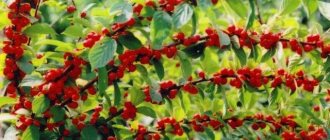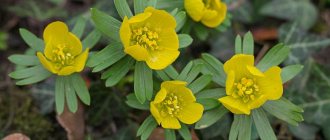Features of climbing roses
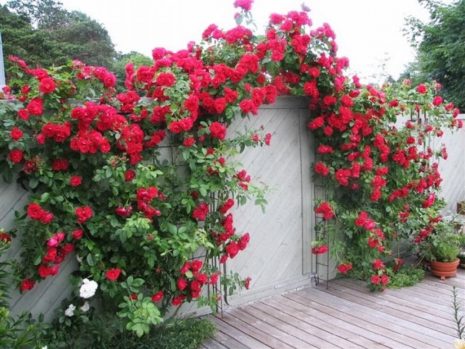
Beautiful, lianas-like perennials are used for vertical decoration. Roses of this group are spectacular in the frame of columns, gazebos, hedges, arches.
Plants have long hanging shoots (lashes), the length varies from 1.5 to 15 meters. Climbing roses are divided into groups according to the number of petals in flowers:
- terry;
- semi-double;
- simple.
Plants are classified by flower diameter, highlighting small-flowered ramblers, climbers with powerful whips and large, over 4 cm roses. An intermediate position is occupied by semi-leafy varieties, which received the name of shrabs according to the international classification. Climbing roses are unpretentious, frost-resistant, disease-resistant.
On a note!
Roses of this group definitely need a garter to the support.
Ornamental plants of the group are long-flowering, while the category of remontant ones, giving flowers on young shoots, and the category of roses blooming on old shoots, have been derived. The former bloom again during the season, the latter - once. Repaired ones are convenient because, even with a difficult wintering, roses will bloom only at a later date. Roses with a single flowering do not have buds if the shoots are damaged.
For the climate of the Moscow region (No. 4 on the USDA international climate map) climbing roses are an excellent choice, as they tolerate wintering well, are distinguished by abundant and lush constant flowering.
Varieties that bloom all summer
When we look at the description of the varieties of roses, we can often read in the “bloom” column that they bloom once, repeatedly and constantly. Let's take a closer look at this issue.
- With a single flowering, everything is clear - roses have bloomed once, even if for a long time and abundantly, in the future we can see only single random buds on their bushes.
- Constantly blooming - also seems to be understandable. These roses should bloom all season.
- Re-flowering varieties are those in which the first wave of flowering, after a short break, is followed by a second wave, sometimes even more abundant than the previous one. With good care, the roses of this group sometimes bloom continuously until the very frost.
But for some reason, not always constantly and repeatedly flowering varieties fulfill their obligations. Often, after the first lush wave of flowering, only single pitiful buds appear on the bushes, and rather small ones.
Comment! This is only our fault - roses are very fond of "eating", having used up all the accumulated nutrients for an abundant first flowering, they simply cannot continue to form buds without our help.
So read again how to properly care for roses - there should be 7 (!) Dressings, and not counting the foliar ones. Only those who have rich, fertile soils can neglect this rule, and even then they should not cancel feeding, but only reduce their amount.
Climber (large-flowered) climbing roses
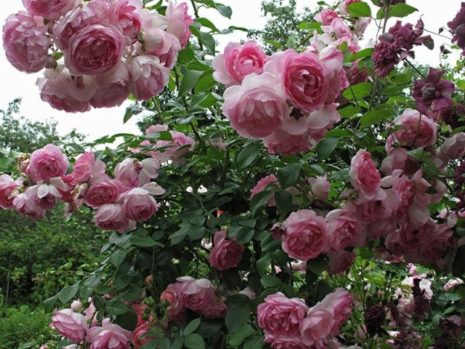

The group includes varieties that are distinguished by large fragrant flowers, tough straight shoots. The length of the lashes is up to 6-7 meters, which makes it possible to use roses for vertical gardening. Climings look spectacular on fences, vertical supports, walls. To create arches, unlike ramblers, such varieties are not suitable due to hard shoots.
Plants are resistant to traditional diseases of ornamental crops, have an average frost resistance. For climbers, roses appear on all shoots (young, perennial), reach 6-8 cm in diameter, very fragrant. The shape, like the colors, is varied.
Of the varieties suitable for growing in the Moscow region, stand out:
Elfe
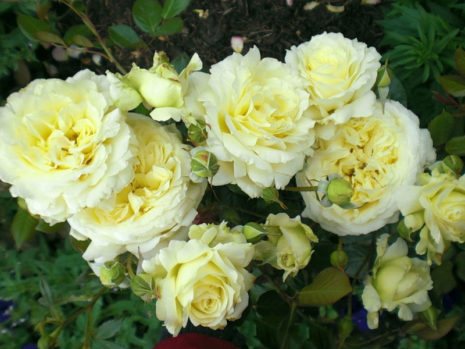

The variety was bred by German breeders, registered in 2000. The powerful bush is covered with a large number of double flowers, the color is ivory with a greenish tint. In one brush - up to 4-5 pieces.
Flowering is long, abundant, with a slight decline in the middle of summer. Shoots grow up to 2-3 meters in length, the diameter of roses is from 7 to 16 cm. Climbing Elf is resistant to powdery mildew, black spot. For the winter in the middle lane, shelter is required, it hibernates well.
Indigoletta
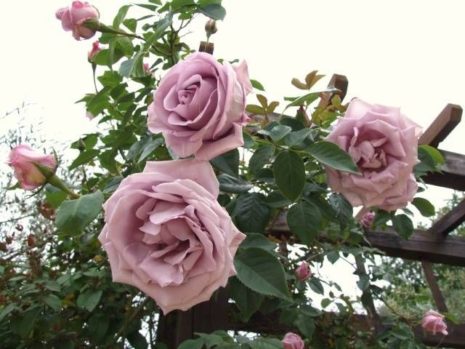

A vigorous large-flowered variety bred in Holland in the 80s of the XX century. Differs in the rapid growth of the bush, high decorative, remontability.
The shoots are powerful, the length of the hard lashes is up to three meters. The bush grows in width to one and a half meters. The flowers are goblet, the buds are dark purple, lilac when blooming. The rose forms up to 25-30 petals, a strong pleasant aroma is felt. In the middle lane, with good cover, Indigoletta endures frosts of thirty degrees.
On a note!
Due to the low flexibility of the shoots, arranging a shelter for the winter is laborious.
The Indigoletta variety is photophilous, but in direct sunlight there is a possibility of petals burning out.
Polka (Polka)
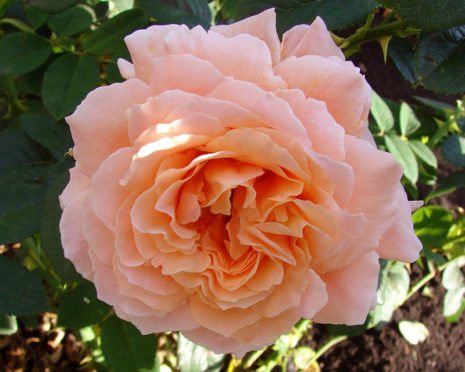

You may be interested in: Low-growing flowers for a flower bed, blooming all summer: description, names and photos Monsters: growing, care and reproduction at home Passionflower: species and varieties with a description, growing and care at home
An incredibly beautiful climbing rose variety with delicate apricot shades with dense double flowers. Shoots reach 6-8 meters, spreading up to 2 meters wide. Winter-hardy, unpretentious French variety, popular among European florists.
Roses are large, up to 12 cm in diameter, with petals changing shade. The color scheme of flowers changes depending on the illumination of the bush from orange to light cream shade. Buds are formed on shoots for 2-3 years, blooms twice a season.
The Climber Polka needs strong support, as the branches lean to the ground under the weight of the flowers. Feature of the variety: high resistance to fungal infections, in the middle lane and to the north, shelter is required for the winter.
Santana (Santana)
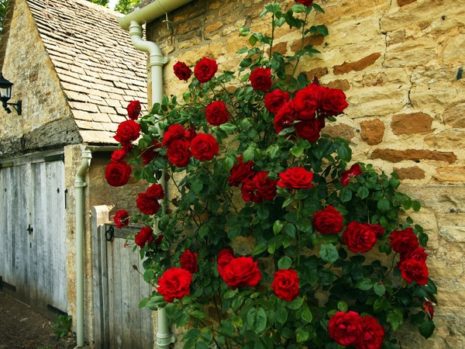

Climber, included in the international top 10 of the most popular red climbing roses. One of the best for growing in the Moscow region, frost-resistant, unpretentious variety.
The flowers are large, blood-red in color, they look spectacular against the background of dark green leaves. Up to 5 buds with a diameter of up to 10 cm are formed on the stem. The largest flowers are formed in the first year, later the inflorescences become smaller, but decorativeness is not lost due to the large number of brushes. The lashes are 3 meters long. Santana is widely used to decorate gazebos and fences.
Don Juan
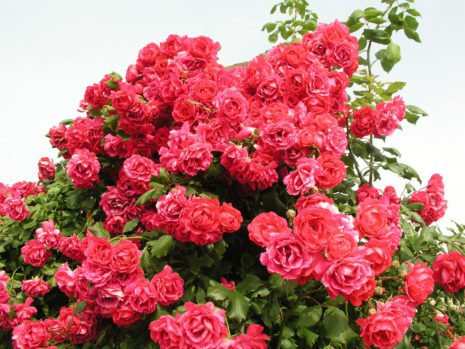

Magnificent climber, distinguished by lush flowering, powerful bush, unpretentiousness. Variety Don Juan received a "residence permit" from gardeners near Moscow, it is appreciated for its easy care, frost resistance, abundant flowering.
Shoots reach a length of 3-4 meters, tough, vigorous, with large thorns. 1-2 buds are formed on the stem, the diameter is 9-10 cm, the petals are cherry-scarlet, with a strong fragrant aroma.
Basically, the formation of buds occurs on the shoots of the current year. In the conditions of the middle zone and the southern regions of the North-West, the Don Juan variety is formed in the form of a shrub. The variety is resistant to black spot.
Sympathie
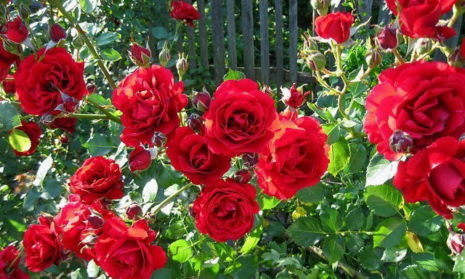

Variety from the Cordes family, bred in Germany.One of the most famous of the red climbing climbers. The bush reaches a height of 4-4.5 meters, a strong support is required. Lush flowering, begins around mid-June and continues under favorable conditions and care until October.
Flowers up to 8-10 cm in diameter, with a weak aroma. On the shoot, from 2 to 10 roses are formed. An unpretentious, infection-resistant variety that requires shelter for the winter.
Casino
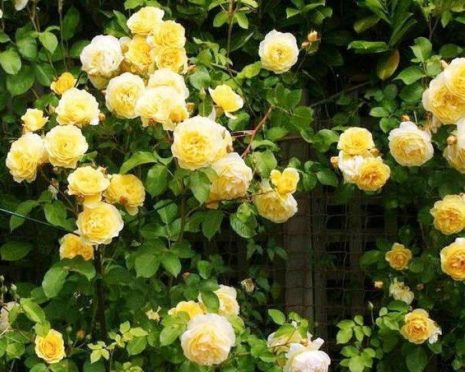

Climber with highly developed shoots, bred in Ireland, by representatives of the famous McGready breeding school. Variety Casino is valued for its abundant flowering, bright sunny yellow shade of flowers, unpretentiousness.
Benefits:
- renovation;
- rapid growth of shoots;
- resistance to infections.
The bushes of the variety are very decorative, they are used to decorate vertical structures. The length of the shoots is up to 3 meters, up to 4-5 flowers are formed on the stem. The open buds are densely double, the inner petals are colored more intensely, the outer ones are of a delicate shade.
The variety needs shelter for the winter, while, despite the hard and dense shoots (a feature of all climbers), it is not difficult to lay it for the winter. Differs in high resistance to fungal diseases. Gives a lush bloom in the middle lane, regions of the North-West, in Tatarstan.
Amadeus
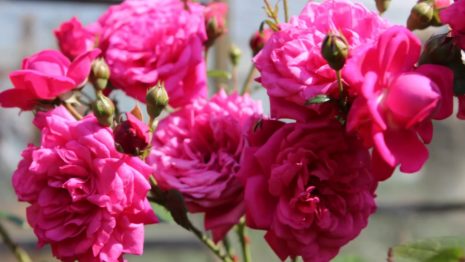

For the design of fences, arches, walls, the abundantly flowering Amadeus variety is suitable. Belongs to the William Cordes family of roses, hybrid, created in 2003.
The bushes are powerful, up to 2.8-3 meters high, the shoots are easily fixed on supports of different configurations. Photophilous variety, although it gives abundant flowering in light shade.
Large bright red roses reach a diameter of 10 cm. The aroma is delicate, with pronounced fruity notes. Blooms all summer, the color of the petals changes from scarlet to purple.
On a note!
Amadeus is highly resistant to black spot and powdery mildew.
In plantings, it is effective as a tapeworm, and also goes well with conifers. It is unpretentious, tolerates severe frosts, but it is recommended to cover it for the winter.
Florentina (Florentina)
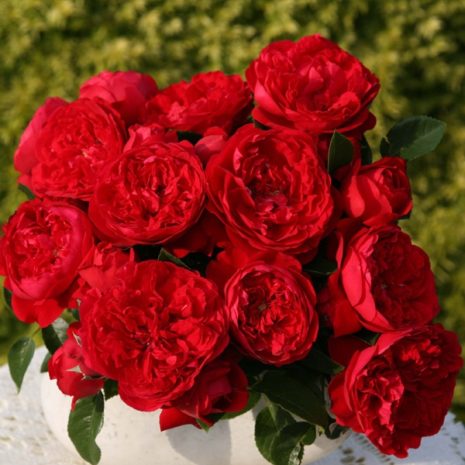

Climbing rose variety from the Kordes family (Germany). Magnificent climber with lush flowering, suitable for the climate of the Moscow region.
The bushes are vigorous, with thick shoots, the whips reach three meters in length. Leaves are dense, with a glossy, dark green surface. Flowers up to 10-11 cm in diameter, cupped, collected in inflorescences of 2-5 pieces. The color is bright red.
Florentina is highly resistant to disease, the flowers do not suffer from prolonged rainfall, the petals do not fade under the sun's rays, while maintaining brightness. The unpretentious climber tolerates wintering well, but requires shelter.
Diseases, pests and ways to control them
German roses Kordes are quite resistant to pests. With improper care, aphids, spider mites or thrips can appear on them. In autumn and winter, the plant can become infected with gray mold or powdery mildew.


Spraying bushes
Important! To prevent the development of pathologies, it is necessary to carry out periodic preventive spraying and treatment with fungicides.
Flowers of Cordes are beautiful and unpretentious. They are often used for landscape design, help to refine the territory or simply create beautiful bouquets. Flowers of this group are distinguished by a variety of shades and shapes, which allows you to choose the right plant for every taste.
Rambler (small-flowered roses)
Plants in this group form long, thin, arc-like shoots, 3 to 15 meters long. The formation of flowers occurs on the shoots of the last year, therefore, it is necessary to especially carefully cover the roses for the winter.
The flowers are small, up to 3-4 cm, of various colors. Usually, rambler roses have little or no aroma, but everything is compensated by abundant flowering.
Almost all varieties of the group bloom once, forming flowers along the entire length of the stems.Rambler are appreciated for their unpretentiousness, frost resistance, ease of organizing wintering of plants.
Super Excelsa
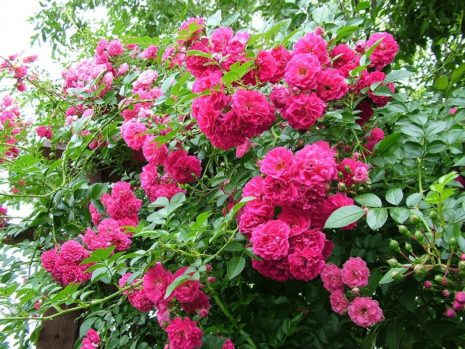

Variety from the rambler group, distinguished by long flowering. The bush forms shoots up to 3-3.5 meters, the width of the bush is up to 2 meters. The formation of flowers proceeds along the entire length of the stems, therefore, the leaves of the plant are often not visible behind the number of flowers.
On one shoot, from 3 to 10 flowers are formed. The roses reach 4 cm in diameter, the color is crimson-red.
Florists of the Moscow region note the high resistance of Super Excelsa to black spot, powdery mildew.
Snowgoose
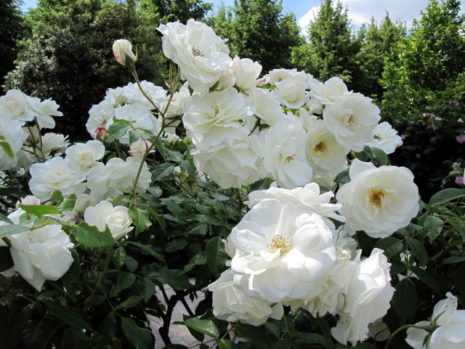

Incredibly beautiful, as if covered with snow, the blossoming Snow Goose rose bush attracts everyone's attention. In large racemes small dense flowers are collected, each up to 4 cm in diameter. In a brush - up to 20 flowers. The color is pure white.
The shoots of the bush grow up to three meters in length. The plant is vigorous, branched, with shiny small dark green foliage. There are few thorns.
The variety is used for vertical design of supports, suitable as a ground cover rose. Resistance to infections, freezing temperatures is high. In the middle lane, Snow Goose is sheltered for the winter.
Rambling Rector


A popular variety from the rambler group, it was first introduced in the nursery in Newry (Ireland). On the vigorous shoots of the plant, a lot of semi-double small creamy white roses are formed. The diameter of the flowers is up to 3-4 cm. The aroma is weak, with a musky note.
Scourges in the climatic conditions of central Russia grow up to 3.5 meters, in the south - up to 5 meters. The leaves are small, pale green, beautifully shaped.
Flowers are collected in inflorescences of 15-50 pieces. In the sun, the petals quickly fade, acquiring a pure white tint. The variety can be cut well, often grown as a scrub (shrub).
Bobbie james


Surprises with lush flowering and strong pleasant aroma. Belongs to the group of ramblers with white flowers, forms many inflorescences-brushes. One brush contains 6-15 flowers.
The bush is vigorous, a large enough area is required for growing. Variety Bobbie James blooms once, usually from mid-June to late July or early August, suitable for gazebos, arches, pergolas, building walls, fences.
Advantages of the variety:
- frost resistance;
- high immunity to diseases;
- easy care;
- unpretentiousness to nutrition and soil types;
- resistance of flowers to fading and precipitation.
The Bobbie James variety from English breeders has been successfully grown by flower growers in the Moscow region for many years.
Super dorothy


Of the re-flowering ramblers, the favorite of mid-lane growers is the Super Dorothy variety. Bred in Germany, it is characterized by increased winter hardiness, resistance to infections.
Sprawling bush, with thin thornless shoots up to 3-4 meters long. Flowers are small, pompom type, collected in brushes of 20-40 pieces. The color is bright crimson.
On a note!
In this variety, the flowers fade in the sun, so it is advisable to provide for a light partial shade.
Flowering begins late, but continues until the very cold. The shoots are soft, pliable, so Super Dorothy is suitable for decorating any supports and structures. Due to its increased resistance to subzero temperatures, the variety winters well in the conditions of the Moscow region; in mild winters, shelter is not required.
Description of the variety
Floribunda means that the bushes have a lush and abundant flowering. There are a huge number of subtypes of varieties that differ in appearance. No other group has so many varieties. Flowers can be simple, and semi-double, and double, can have a goblet or flat calyx, can be collected in small or large inflorescences. The flower size is usually 4 to 9 cm.
Most Floribunda roses bloom in three approaches. Flowers gradually open in several pieces. There are also varieties that bloom continuously.
There are several advantages that make Floribunda roses stand out from the rest. This should include:
- resistance to low temperatures;
- resistance to typical flower diseases;
- ease of care;
- the possibility of propagation by cuttings.
Floribunda roses are actively used for outdoor landscaping of the territory. They look great in parks or in flowerbeds near large visited buildings. Some varieties are used as cuttings.
Semi-twisted roses
These varieties of roses are distinguished by powerful shoots, beautiful fragrant flowers, double flowering. The length of the shoots is up to 2-2.5 meters, they are tough, bend poorly, therefore, they are suitable for vertical supports.
The name "semi-plaited" is becoming a thing of the past, since among the breeders a different name "shraba" or Modern Shrub is adopted.
Ilse Krohn Superior
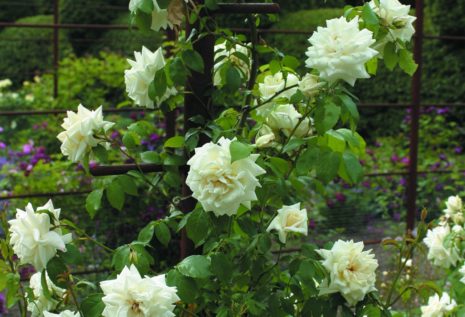

The beautiful white flowers of the Ilse Krohn Superior cultivar are harmoniously combined with the dark green foliage of the plant. The rose is beautiful, unpretentious, resistant to fungal infections, which makes it the best choice for growing in difficult conditions of the middle zone of the Russian Federation.
Shoots grow up to 2 meters, a bush three meters wide. It blooms twice a season. Flowers are formed singly or in clusters of 3-4 pieces. The shape of the flowers is goblet, the petals are dense, waxy, creamy yellow. Diameter - 10-13 cm. The variety easily tolerates wintering, requires shelter.
Laguna
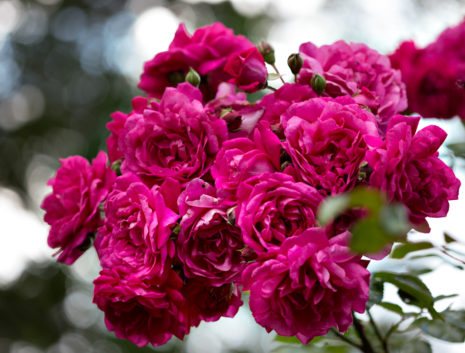

The new generation variety, bred in Germany in 2004, belongs to the Kordes family. It is advisable to grow near straight supports; it is not suitable for decorating arches.
Large flowers, up to 10 cm in diameter, are collected in inflorescences of 6-8 pieces. Coloring - dark crimson, pink. The bushes reach a height of 3 meters and a width of 1 meter.
Flowering occurs in two waves, there is no break. The variety is resistant to infections, shelter is required for the winter. When pruning, leave at least 50 cm of the length of the shoots.
Flammentanz
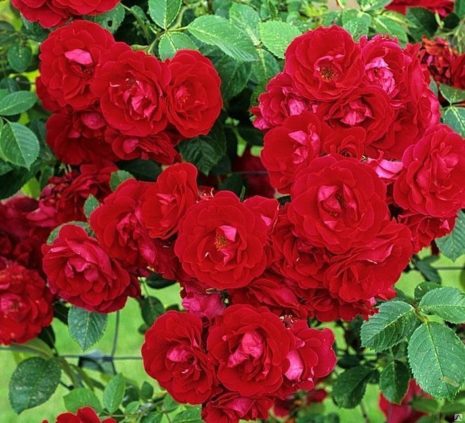

Variety - "hello" from the distant 50s of the XX century, bred by German breeders, in the well-known company Kordes. It is considered one of the best varieties of crimson climbing roses.
Stems grow no more than 2-2.5 meters in length, flowers are formed on the shoot singly or 3-4 pieces. The color of the petals is dark pink, crimson, very bright.
On a note!
The Flammentants variety blooms for only 30-40 days, but the short period is compensated by the brightness and splendor of the inflorescences.
The beginning of flowering in the Moscow region falls on the first ten days of June. The rose is resistant to fungal infections, it is highly winter-hardy (up to minus 40 degrees).
Golden Gate
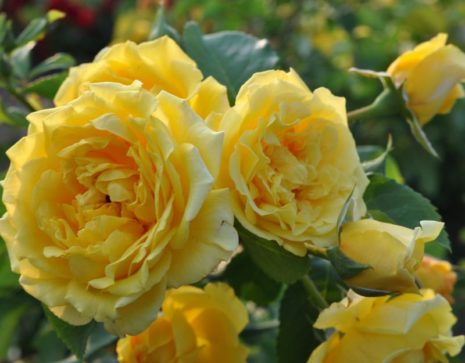

Unlike the previous variety, this rose will delight you with long flowering from June to September. The flower is popular because of the unusual, yellow-white inflorescences that abundantly cover the entire bush.
The plant reaches a height of 2 meters, is compact. The flowers are medium in size, about 7-8 cm, bloom in inflorescences of 6-10 pieces. It is recommended to remove faded buds, as they do not fall off.
Feature of the variety: high winter hardiness, strong aroma (smells good of citrus), can be grown in Siberia, in the North-West.
Rosa Cordes (Kordes) - what is this garden group, the history of creation
Rosa Cordes is a young group that has emerged thanks to the Rugosa and Vihurayan varieties. The founder of this species was the head of the company Kordes, she was one of the ten best rose nurseries around the world. This company today has many varieties and hybrid inflorescences.
Brief description of the cattery, characteristics
Nursery Cordes is a well-known organization that is famous for the production of seedlings, crossing different varieties of roses and breeding new types of inflorescences. The organization began its existence in 1887, and was founded by Wilhelm Cordes. The gardener's descendants continued their work, and for more than 100 years the organization has been engaged in the selection and propagation of greenhouse roses.
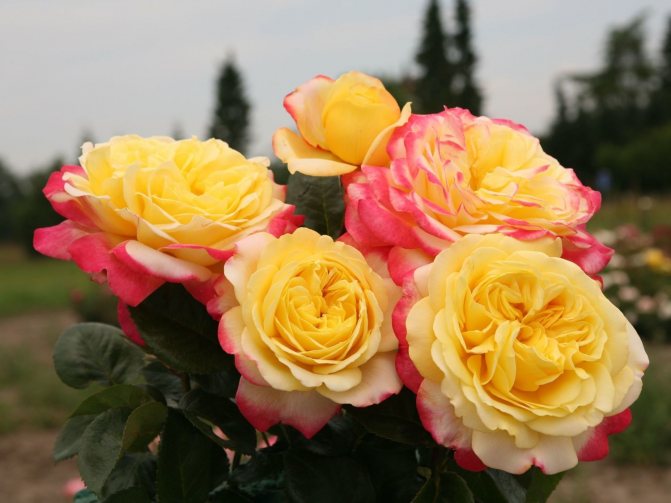

Rosa Cordes
Follow-up care
A bush of roses of the Cordes group keeps its shape well, so it does not need to be tied up and substituted to the support stems. Fertilize plants at will, as they do not need regular feeding.
In areas with a warm climate, roses are grown without insulation, but in the northern regions they need to be covered for the winter, no matter how hardy they are. To do this, the bushes do not need to be pruned, it is enough to bend the branch to the ground, spreading spruce paws under them. Roses are insulated with burlap, roofing felt or dry leaf.
Diseases and pests
Roses of Cordes are generally quite resistant to disease, but under unfavorable conditions, plants can damage aphids, thrips or spider mites. Rust and gray mold contamination is also possible. Powdery mildew and black spotting of roses are extremely rare.
Important! Some varieties can get burned when planted in the open sun.
Flower propagation
The easiest way to propagate a shrub is by cuttings. As a rule, they are cut from stable and healthy side shoots. The procedure is best done before setting flowers, somewhere in the middle of spring.
Cut off cuttings with a diameter of 3-5 millimeters and a length of 15 centimeters. Places of cuts are treated with "Kornevin", after which they are placed for 3 hours in ordinary water. Sections are planted in a box with a substrate and covered with a transparent glass or plastic dome. A month later, the cuttings will take root firmly.
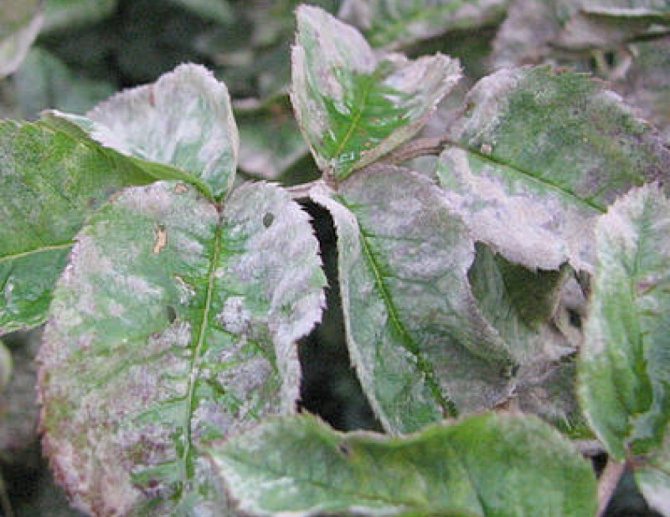

Powdery mildew on the leaves
Plant care
For flowering to pass without problems, you must remember the rules for caring for roses after planting.
Watering rules and humidity
For good growth, roses need regular watering. It is necessary to actively water the inflorescences during the growing season - from early spring to late autumn. This approach will help to saturate the soil with moisture and prevent dryness, death of flowers and the appearance of pests.
Top dressing and soil quality
To nourish the root system, plants need to be fertilized regularly. Top dressing is recommended in spring, summer and autumn. At the beginning of the growing season, it is better to apply mineral fertilizers. In summer and autumn, it is worth focusing on organic feeding.
Important! After cultivation, the soil should be loosened so that the fertilizer can get to the root system.
Pruning and replanting
It is better to cut flowers in spring, before the period of active flowering. At this time, you need to inspect the shrubs and remove dried or rotten stems and leaves. If most of the bush is affected, do not be afraid to cut off all the branches. This will help the plant recover faster.
It is best to use sharp scissors or pruning shears to prevent damage.
Important! Ornamental and landscape varieties are best transplanted into pots or greenhouses. This refers to the Rose Princess de Luxembourg, Blue Boy, Apricola.
Features of wintering a flower
Many varieties of Cordes roses do not need shelter and transplanting before the onset of cold weather, since this is a winter-hardy species. To prevent diseases and the appearance of pests, the bushes before the cold weather need to carefully examine and remove the affected areas. It is also recommended to apply organic fertilizers and periodically loosen the soil.
On the basic principles of agricultural technology
Hybrid tea roses
Roses of the Cordes group are very easy to grow, which is perhaps the main advantage of this variety over others. These plants do well both in the shade and in the sun. They successfully take root on almost all types of soils, are resistant to any weather conditions and sudden changes in temperature.
Landing
The optimal planting time is May-June or September-October. Better to plant bushes in cloudy weather. If at the site for planting groundwater lies close to the surface of the earth, then drainage from rubble should be laid at the bottom of the planting pit.


You can put a layer of compost on the bottom of the planting pit
Immediately before planting the plant, you can lay a layer of compost (about 5 cm, no more) on the bottom of the planting pit. The top fertile soil layer pours out on top. This is done to avoid direct contact of the roots of the bush with the fertilizer.
The depth of the pit should be on average 30-40 cm.
Important! The varieties of Cordes cannot be planted in places where other roses have been growing for more than 5 years.









